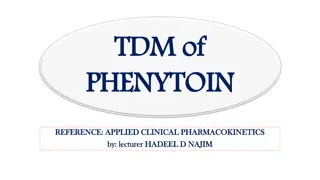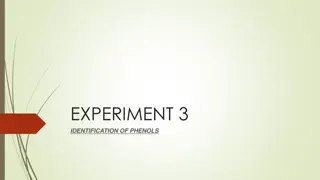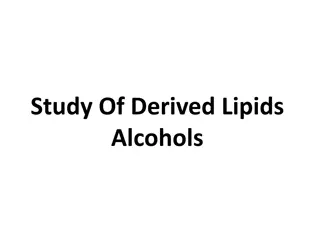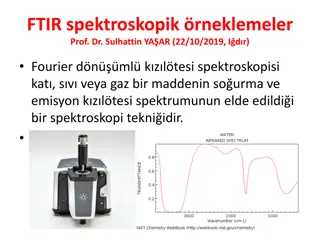Understanding the Binding Role of Alcohols and Phenols in Drug Molecules
The role of alcohols and phenols in drug molecules is crucial as they are frequently involved in hydrogen bonding interactions. By creating analogues with modified functional groups, such as ethers and esters, the importance of specific groups can be determined. The presence or absence of hydrogen bond donor and acceptor capabilities, as well as electronic properties, significantly influences the biological activity of the compounds. Testing these analogues helps identify essential groups for drug activity.
Download Presentation

Please find below an Image/Link to download the presentation.
The content on the website is provided AS IS for your information and personal use only. It may not be sold, licensed, or shared on other websites without obtaining consent from the author. Download presentation by click this link. If you encounter any issues during the download, it is possible that the publisher has removed the file from their server.
E N D
Presentation Transcript
Structure Activity Relationships Structure Activity Relationships We have to identify which of these interactions take place actually By synthesizing analogues where one particular functional group of the molecule is removed or altered, it is possible to find out which groups are essential and which are not Th is involves testing all the analogues for biological activity and comparing them with the original compound If an analogue shows a significantly lowered activity, then the group that has been modified must have been important If the activity remains similar, then the group is not essential
Binding role of alcohols and phenols Binding role of alcohols and phenols Alcohols and phenols are functional groups which are commonly present in drugs and are often involved in hydrogen bonding. The oxygen can act as a hydrogen bond acceptor, and the hydrogen can act as a hydrogen bond donor Synthesizing a methyl ether or an ester analogue can disrupt the hydrogen bonding in both analogues There are two reasons why the ether might hinder or prevent the hydrogen bonding of the original alcohol or phenol.
Binding role of alcohols and phenols Binding role of alcohols and phenols The proton of the original hydroxyl group is involved as a hydrogen bond donor and, by removing it, the hydrogen bond is lost. However, suppose the oxygen atom is acting as a hydrogen bond acceptor. The oxygen is still present in the ether analogue but the extra bulk of the methyl group could prevent the close interaction which cause hydrogen bonding.
Binding role of alcohols and phenols Binding role of alcohols and phenols
Binding role of alcohols and phenols Binding role of alcohols and phenols An ester analogue cannot act as a hydrogen bond donor. There is still the possibility of it acting as a hydrogen bond acceptor, but the extra bulk of the acyl group is greater than the methyl group of the ether, and this should hinder the original hydrogen bonding interaction. There is also a difference between the electronic properties of an ester and an alcohol. The carboxyl group has a weak pull on the electrons from the neighbouring oxygen, giving the resonance structure.
Binding role of alcohols and phenols Binding role of alcohols and phenols
Binding role of alcohols and phenols Binding role of alcohols and phenols Because the lone pair is involved in such an interaction, it will be less effective as a hydrogen bond acceptor One could then argue that the carbonyl oxygen is potentially a more effective hydrogen bond acceptor but it is in a different position relative to the rest of the molecule and may be poorly positioned to form an effective hydrogen bond interaction with the target binding region.
Binding role of aromatic rings Binding role of aromatic rings Aromatic rings are planar, hydrophobic structures, commonly involved in van der Waals interactions with flat hydrophobic regions of the binding site. An analogue containing a cyclohexane ring in place of the aromatic ring is less likely to bind so well, as the ring is no longer flat. The axial protons can interact weakly, but they also serve as buffers to keep the rest of the cyclohexane ring at a distance. Th e binding region for the aromatic ring may also be a narrow slot rather than a planar surface. In that scenario, the cyclohexane ring would be incapable of fitting into it, because it is a bulkier structure.
Binding role of aromatic rings Binding role of aromatic rings
The binding role of ketones The binding role of ketones and aldehydes A ketone group is a planar group that can interact with a binding site through hydrogen bonding where the carbonyl oxygen acts as a hydrogen bond acceptor. Two such interactions are possible, as two lone pairs of electrons are available on the carbonyl oxygen. The lone pairs are in sp2-hybridized orbitals which are in the same plane as the functional group. The carbonyl group also has a significant dipole moment and so a dipole dipole interaction with the binding site is also possible. and aldehydes
The binding role of ketones The binding role of ketones and aldehydes and aldehydes It is relatively easy to reduce a ketone to an alcohol and it may be possible to carry out this reaction directly on the lead compound. This significantly changes the geometry of the functional group from planar to tetrahedral. Such an alteration in geometry may well weaken any existing hydrogen bonding interactions and will certainly weaken any dipole dipole interactions, as both the magnitude and orientation of the dipole moment will be altered Aldehydes are less common in drugs because they are more reactive and are susceptible to metabolic oxidation to carboxylic acids. They could interact in the same way as ketones, and similar analogues could be studied.
The binding role of ketones The binding role of ketones and aldehydes and aldehydes
The binding role of amines The binding role of amines Amines are extremely important functional and are present in many drugs. They may be involved in hydrogen bonding, either as a hydrogen bond acceptor or a hydrogen bond donor The nitrogen atom has one lone pair of electrons and can act as a hydrogen bond acceptor for one hydrogen bond. Primary and secondary amines have N H groups and can act as hydrogen bond donors. Aromatic and heteroaromatic amines act only as hydrogen bond donors because the lone pair interacts with the aromatic or heteroaromatic ring.
The binding role of amines The binding role of amines
The binding role of amines The binding role of amines In many cases, the amine may be protonated when it interacts with its target binding site, which means that it is ionized and cannot act as a hydrogen bond acceptor. However, it can still act as a hydrogen bond donor and will form stronger hydrogen bonds than if it was not ionized. Alternatively, a strong ionic interaction may take place with a carboxylate ion in the binding site
The binding role of amines The binding role of amines
The binding role of amines The binding role of amines To test whether ionic or hydrogen bonding interactions are taking place, an amide analogue could be studied. This will prevent the nitrogen acting as a hydrogen bond acceptor, as the nitrogen s lone pair will interact with the neighbouring carbonyl group. This interaction also prevents protonation of the nitrogen and rules out the possibility of ionic interactions. You might argue that the right-hand structure in the figure below has a positive charge on the nitrogen and could still take part in an ionic interaction. However, this resonance structure represents one extreme and is never present as a distinct entity. The amide group as a whole is neutral, and so lacks the net positive charge required for ionic bonding.
The binding role of amines The binding role of amines
The binding role of amines The binding role of amines It is relatively easy to form secondary and tertiary amides from primary and secondary amines, respectively, and it may be possible to carry out this reaction directly on the lead compound. A tertiary amide lacks the N H group of the original secondary amine and would test whether this is involved as a hydrogen bond donor. The secondary amide formed from a primary amine still has a N H group present, but the steric bulk of the acyl group should hinder it acting as a hydrogen bond donor
The binding role of amines The binding role of amines Tertiary amines cannot be converted directly to amides, but if one of the alkyl groups is a methyl group, it is often possible to remove it with vinyloxycarbonyl chloride (VOC-Cl) to form a secondary amine, which could then be converted to the amide. This demethylation reaction is extremely useful and has been used to good effect in the synthesis of morphine analogues























